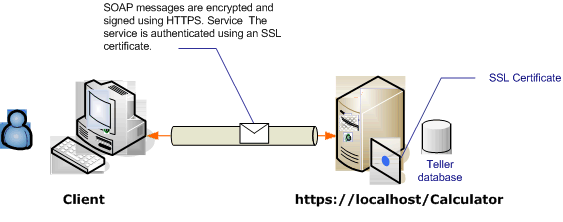Segurança de transporte com um cliente anônimo
Este cenário do Windows Communication Foundation (WCF) usa segurança de transporte (HTTPS) para garantir confidencialidade e integridade. O servidor deve ser autenticado com um certificado SSL (Secure Sockets Layer) e os clientes devem confiar no certificado do servidor. O cliente não é autenticado por nenhum mecanismo e, portanto, é anônimo.
Para obter um aplicativo de exemplo, consulte Segurança de transporte do WS. Para obter mais informações sobre segurança de transporte, consulte Visão geral de segurança de transporte.
Para obter mais informações sobre como usar um certificado com um serviço, consulte Trabalhando com certificados e Como configurar uma porta com um certificado SSL.

| Characteristic | Description |
|---|---|
| Modo de Segurança | Transporte |
| Interoperabilidade | Com clientes e serviços Web existentes |
| Autenticação (Servidor) Autenticação (Cliente) |
Sim Nível de aplicativo (sem suporte a WCF) |
| Integridade | Sim |
| Confidencialidade | Sim |
| Transporte | HTTPS |
| Enlace | WSHttpBinding |
Serviço
O código e a configuração a seguir devem ser executados de forma independente. Execute um dos seguintes procedimentos:
Crie um serviço autônomo usando o código sem configuração.
Crie um serviço usando a configuração fornecida, mas não defina nenhum ponto de extremidade.
Código
O código a seguir mostra como criar um ponto de extremidade usando a segurança de transporte:
// Create the binding.
WSHttpBinding binding = new WSHttpBinding();
binding.Security.Mode = SecurityMode.Transport;
binding.Security.Transport.ClientCredentialType =
HttpClientCredentialType.None;
// Create the URI for the endpoint.
Uri httpUri = new Uri("https://localhost/Calculator");
// Create the service host and add an endpoint.
ServiceHost myServiceHost =
new ServiceHost(typeof(ServiceModel.Calculator), httpUri);
myServiceHost.AddServiceEndpoint(
typeof(ServiceModel.ICalculator), binding, "");
// Open the service host.
myServiceHost.Open();
Console.WriteLine("Press Enter to exit....");
Console.ReadLine();
// Close the service.
myServiceHost.Close();
' Create the binding.
Dim binding As New WSHttpBinding()
binding.Security.Mode = SecurityMode.Transport
binding.Security.Transport.ClientCredentialType = HttpClientCredentialType.None
' Create the URI for the endpoint.
Dim httpUri As New Uri("https://localhost/Calculator")
' Create the service host and add an endpoint.
Dim myServiceHost As New ServiceHost(GetType(ServiceModel.Calculator), httpUri)
myServiceHost.AddServiceEndpoint(GetType(ServiceModel.ICalculator), binding, "")
' Open the service host.
myServiceHost.Open()
Console.WriteLine("Press Enter to exit....")
Console.ReadLine()
' Close the service.
myServiceHost.Close()
Configuração
O código a seguir configura o mesmo ponto de extremidade usando a configuração. O cliente não é autenticado por nenhum mecanismo e, portanto, é anônimo.
<?xml version="1.0" encoding="utf-8"?>
<configuration>
<system.serviceModel>
<services>
<service name="ServiceModel.Calculator">
<endpoint address="https://localhost/Calculator"
binding="wsHttpBinding"
bindingConfiguration="WSHttpBinding_ICalculator"
name="SecuredByTransportEndpoint"
contract="ServiceModel.ICalculator" />
</service>
</services>
<bindings>
<wsHttpBinding>
<binding name="WSHttpBinding_ICalculator">
<security mode="Transport">
<transport clientCredentialType="None" />
</security>
</binding>
</wsHttpBinding>
</bindings>
<client />
</system.serviceModel>
</configuration>
Cliente
O código e a configuração a seguir devem ser executados de forma independente. Execute um dos seguintes procedimentos:
Crie um cliente autônomo usando o código (e o código do cliente).
Crie um cliente que não defina nenhum endereço de ponto de extremidade. Em vez disso, use o construtor cliente que usa o nome da configuração como um argumento. Por exemplo:
CalculatorClient cc = new CalculatorClient("EndpointConfigurationName");Dim cc As New CalculatorClient("EndpointConfigurationName")
Código
// Create the binding.
WSHttpBinding myBinding = new WSHttpBinding();
myBinding.Security.Mode = SecurityMode.Transport;
myBinding.Security.Transport.ClientCredentialType =
HttpClientCredentialType.None;
// Create the endpoint address. Note that the machine name
// must match the subject or DNS field of the X.509 certificate
// used to authenticate the service.
EndpointAddress ea = new
EndpointAddress("https://machineName/Calculator");
// Create the client. The code for the calculator
// client is not shown here. See the sample applications
// for examples of the calculator code.
CalculatorClient cc =
new CalculatorClient(myBinding, ea);
// Begin using the client.
try
{
cc.Open();
Console.WriteLine(cc.Add(100, 1111));
// Close the client.
cc.Close();
}
' Create the binding.
Dim myBinding As New WSHttpBinding()
myBinding.Security.Mode = SecurityMode.Transport
myBinding.Security.Transport.ClientCredentialType = HttpClientCredentialType.None
' Create the endpoint address. Note that the machine name
' must match the subject or DNS field of the X.509 certificate
' used to authenticate the service.
Dim ea As New EndpointAddress("https://machineName/Calculator")
' Create the client. The code for the calculator
' client is not shown here. See the sample applications
' for examples of the calculator code.
Dim cc As New CalculatorClient(myBinding, ea)
' Begin using the client.
Try
cc.Open()
Console.WriteLine(cc.Add(100, 11))
Console.ReadLine()
' Close the client.
cc.Close()
Catch tex As TimeoutException
Console.WriteLine(tex.Message)
cc.Abort()
Catch cex As CommunicationException
Console.WriteLine(cex.Message)
cc.Abort()
Finally
Console.WriteLine("Closed the client")
Console.ReadLine()
End Try
Configuração
A configuração a seguir pode ser usada em vez do código para configurar o serviço.
<configuration>
<system.serviceModel>
<bindings>
<wsHttpBinding>
<binding name="WSHttpBinding_ICalculator" >
<security mode="Transport">
<transport clientCredentialType="None" />
</security>
</binding>
</wsHttpBinding>
</bindings>
<client>
<endpoint address="https://machineName/Calculator"
binding="wsHttpBinding"
bindingConfiguration="WSHttpBinding_ICalculator"
contract="ICalculator"
name="WSHttpBinding_ICalculator" />
</client>
</system.serviceModel>
</configuration>